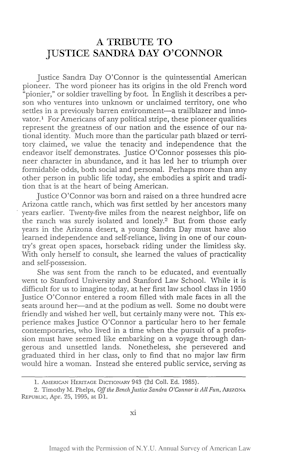A Tribute to Justice Sandra Day O’Connor
January 1996

Other pages in the O'Connor Institute Online Archive mentioned in this article:
| NAME / TITLE | TYPE |
|---|---|
| Katherine L. Adams | Law Clerk |
Article Text
(Excerpt)
A TRIBUTE TO
JUSTICE SANDRA DAY O'CONNOR
Justice Sandra Day O'Connor is the quintessential American pioneer. The word pioneer has its origins in the old French word "pionier," or soldier travelling by foot. In English it describes a per son who ventures into unknown or unclaimed territory, one who settles in a previously barren environment-a trailblazer and inno vator.1 For Americans of any political stripe, these pioneer qualities represent the greatness of our nation and the essence of our na tional identity. Much more than the particular path blazed or terri tory claimed, we value the tenacity and independence that the endeavor itself demonstrates. Justice O'Connor possesses this pio neer character in abundance, and it has led her to triumph over formidable odds, both social and personal. Perhaps more than any other person in public life today, she embodies a spirit and tradi tion that is at the heart of being American.
Justice O'Connor was born and raised on a three hundred acre Arizona cattle ranch, which was first settled by her ancestors many
years earlier. Twenty-five miles from the nearest neighbor, life on the ranch was surely isolated and lonely.2 But from those early years in the Arizona desert, a young Sandra Day must have also learned independence and self-reliance, living in one of our coun try's great open spaces, horseback riding under the limitless sky. With only herself to consult, she learned the values of practicality and seU:possession.
She was sent
